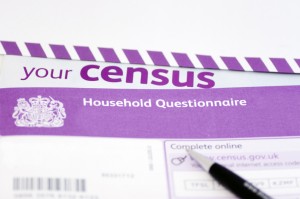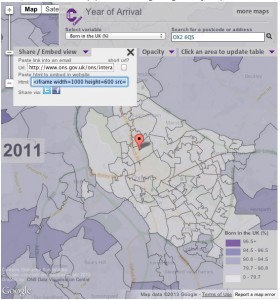The census is the most complete source of information about the population of the UK. It is particularly useful for obtaining population estimates for small geographical areas and information on the characteristics of such a population. Other sources of information on population characteristics in the UK, such as the Labour Force Survey, have large margins of error at the local level because they are based on survey data and rely on a limited number of observations at the local level. The census is based on a count of people and households, with efforts to include everyone.
 The latest UK censuses were conducted during 2011, with 27 March 2011 as the official census day of record. The first release of statistics from the 2011 England and Wales Census was published on 16 July 2012. That means that for the first time in a decade there is accurate local level data on the population and its characteristics.
The latest UK censuses were conducted during 2011, with 27 March 2011 as the official census day of record. The first release of statistics from the 2011 England and Wales Census was published on 16 July 2012. That means that for the first time in a decade there is accurate local level data on the population and its characteristics.
The 2011 England and Wales Census contained several questions which relate directly to migration, including information on:
1. Country of birth
2. Passports held (proxy for nationality)
3. Year of arrival
4. Languages spoken
The Migration Observatory has recently launched a fascinating new project page to make migration-related 2011 Census data available through a suite of outputs, including videos, interactive charts, interactive maps, region specific profiles and commentaries. This project is financed principally by an ESRC (Economic and Social Research Council) Knowledge Exchange grant. The discussion below lists some of the most exciting features of this page.
The videos available at the Migration Observatory new project section include an interview with Rob McNeil, the Migration Observatory press contact, together with Peter Stokes, the 2011 Census Statistical Design Manager. In this video Peter explains the history of the census in the UK and discusses the potential uses of the data and its limitations. In addition, the page includes four ONS videos which cover topics such as foreign-born numbers and shares, languages spoken, the relationship between country of birth and UK passports (this provides some information on the number of foreign-born individuals which have acquired British nationality) and short-term migration, among others.
Interactive charts
The Migration Observatory has assembled key charts from the census on migration-related variables, including a “create your own chart” section. These charts are provided by regions and local areas. For each region and local area it is possible to get charts on the total usual resident population, total number of resident foreign-born individuals and foreign-born share of the population. In addition, there are charts comparing the results of the 2001 and 2011 Censuses, details about regions of origin of the foreign-born, details about length of residence of the foreign-born in the UK, details about dates of arrival of the foreign-born and details about fluency in English, among others.
The page contains five interactive ONS maps which are searchable by postcode. Just put your postcode or your address and you will get local information on the number of total residents, the number of residents born abroad, the year of arrival of those born abroad, passports held, and the number of short-term residents born abroad, among others. More maps will be added to this section during the upcoming months.
Census Profiles
The page contains census profiles for each region of England and Wales which summarise key statistics from the census for the specific region, and its constituent districts and unitary authorities. The profiles provide information about population levels; the number, population share, age and gender of foreign-born residents; as well as countries of origin, main languages and passports held. Finally, the profiles compare each region to other regions of England and Wales and the 2001 and 2011 Census results. At the moment there are profiles available for London and Yorkshire and the Humber (as of 12 June). One new regional profile will be added to the page every month.
Other activities
In addition, to these activities the Migration Observatory has prepared commentaries, press releases and has conducted seminars on the topic for academics, policymakers and leaders of migrants organisations in different regions of the country including London, the West Midlands, and Yorkshire and the Humber. These seminars included a full discussion of the Census results for the region and information about how to access and use the data.
What is not included?
The Migration Observatory project does not cover topics from the census such as ethnicity and religion that may be related to debates on migration at times, but are less directly related to the work of the Observatory. The links below provide useful information on this regard.

